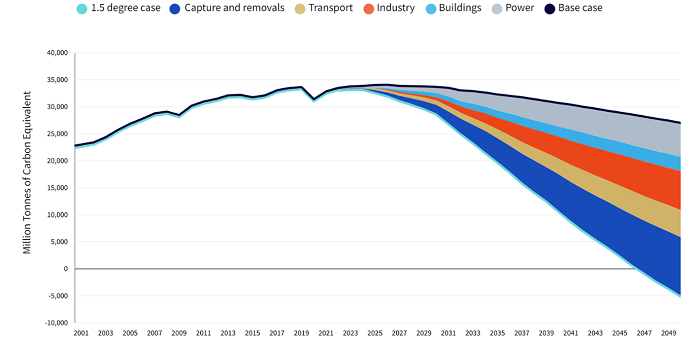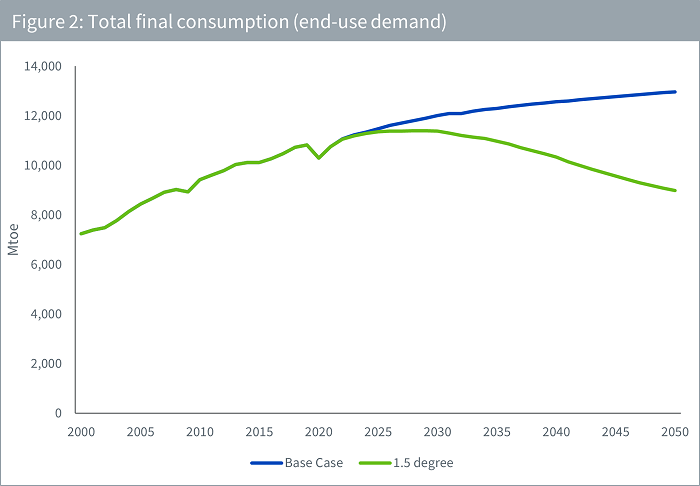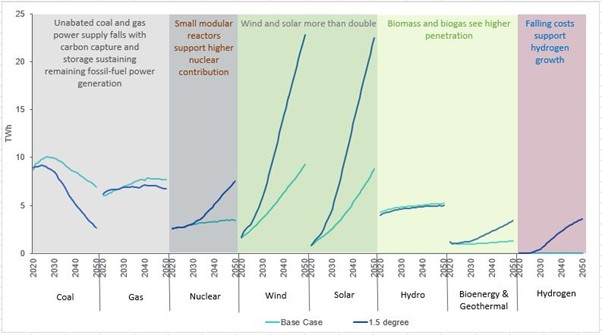“The electric light did not come from the continuous improvement of candles.” – Oren Harari
In the year 1900, the world had a simple energy mix. One half of total energy supply came from coal and the other came from biomass. Gas, oil, and hydropower existed but paled in comparison. Fast forward 121 years, by 2021, things had changed in two key aspects. First, oil and gas had come head-to-head with coal to collectively account for nearly 77% of the energy mix. And second, total energy consumption had increased 14x1.
This drastic increase in our energy consumption, and demand mostly satiated by fossil fuels, has created a problem. It has left us with a carbon budget of 380 gigatons of CO2 equivalent from the start of 2023. In other words, we could hit 1.5°C of warming in 9 years2.
That is, unless things change meaningfully. Not continuous improvement, but radical change. Like shunning fossil fuels for cleaner alternatives. Not only is this essential but, luckily, it is now achievable thanks to the advancement of renewable energy.
At the heart of the energy transition
Consider the gap between the base case (dark blue line in the chart below) in Figure 1 and the path we must adopt in the 1.5°C scenario (teal line). The teal scenario appears to be possible by doing a combination of two things. Where decarbonisation of power and transportation is possible, it must be done. Where it isn’t, say heavy industries like steel and cement, carbon capture must be employed. Scaling up renewable sources of energy, therefore, is at the heart of this endeavour.
Figure 1: The difference between the base case and 1.5 degree and what’s needed to get there

Source: WisdomTree, Wood Mackenzie.
Forecasts are not an indicator of future performance and any investments are subject to risks and uncertainties.
A more efficient alternative
Historically, our total energy consumption has only moved in one direction – upwards. While population growth and advancement in industrialisation and technology are the prime reasons for this, another contributing factor is that energy efficiency has seldom been achieved on a large scale. But with the rapid electrification of transport and buildings, efficiency gains vs using fossil fuels could result in total end-use demand for energy peaking by 2028 and, potentially, declining thereafter (in a 1.5°C scenario).


Source: WisdomTree, Wood Mackenzie. Mtoe = mega tonnes of oil equivalent.
Forecasts are not an indicator of future performance and any investments are subject to risks and uncertainties.
Wind and solar have arrived
Among renewables, wind and solar are expected to play the leading role (see Figure 3). There are numerous reasons for this. First, both technologies have been around long enough to see significant cost reductions in recent years. According to a Bloomberg New Energy Finance report published in June 2022, new onshore wind now costs about $46 per megawatt-hour (MWh), while large-scale solar plants cost $45 per megawatt-hour. In comparison, new coal-fired plants cost $74 per MWh, while gas plants cost $81 per MWh.
Second, most places in the world have access to either wind or sunshine (if not both). The only challenge that needs to be overcome, therefore, is obtaining the necessary funding required to install renewable energy farms.
And third, wind and solar are seeing some exciting innovations. Consider floating offshore wind as an example. Floating offshore wind power has several benefits as a source of renewable energy. First, floating wind turbines can be deployed in deeper waters where traditional fixed-bottom turbines cannot reach. This allows for greater access to stronger and more consistent wind resources, which can generate more electricity at a lower cost. Additionally, floating offshore wind turbines are less visible from shore and have a smaller environmental footprint compared to onshore and fixed-bottom offshore wind farms. Furthermore, floating offshore wind farms have the potential to be located closer to population centres, reducing transmission costs, and improving energy security. Lastly, because they are not limited by the ocean floor, floating wind turbines can be moved to different locations if needed, making them a more flexible option for renewable energy production.
Wind and solar can be complemented by emerging sources of renewable energy like hydrogen. Green hydrogen, which is produced through the renewable electrolysis of water, that is, passing a current of renewable electricity through water, has the potential to help decarbonise both heavy-duty transport like trucks, ships, trains, and airplanes, and energy-intensive industries like steel and coal. As the production of green hydrogen achieves scale, cost-reductions will foster further growth.
Figure 3: Wind and solar have a significantly large role to play in a net zero world


Source: Wood Mackenzie, 2023.
Forecasts are not an indicator of future performance and any investments are subject to risks and uncertainties.
The pathway forward
Renewable energy can help the energy sector deliver net zero with the aid of the following:
1. Effective policy design – regulatory, commercial, and technical barriers to entry be removed.
2. Capital – by 2050, US$47 trillion is required to deliver the generation and infrastructure of a net zero energy system3.
3. Technology – wind and solar will need to be supported by emerging technologies like hydrogen and carbon capture.
4. System flexibility – innovative ways of energy storage and distribution will need to support renewable energy.
5. Sustainability – recycling will need to be scaled up to ensure we efficiently utilise natural resources.
Renewable energy is being fuelled by political will, technological progress, and investor interest. It is an exciting time to employ this tool in our fight against climate change.
Sources
1 Source: Visual Capitalist as of 10 March 2023 with original data from ‘Our World in Data’.
2 Intergovernmental Panel on Climate Change, 2023.
3 Wood Mackenzie, 2023.
—
Originally Posted June 12, 2023 – Renewable energy – a requisite tool for tackling climate change
Join The Conversation
If you have a general question, it may already be covered in our FAQs. If you have an account-specific question or concern, please reach out to Client Services.
Leave a Reply
Disclosure: WisdomTree Europe
This material is prepared by WisdomTree and its affiliates and is not intended to be relied upon as a forecast, research or investment advice, and is not a recommendation, offer or solicitation to buy or sell any securities or to adopt any investment strategy. The opinions expressed are as of the date of production and may change as subsequent conditions vary. The information and opinions contained in this material are derived from proprietary and non-proprietary sources. As such, no warranty of accuracy or reliability is given and no responsibility arising in any other way for errors and omissions (including responsibility to any person by reason of negligence) is accepted by WisdomTree, nor any affiliate, nor any of their officers, employees or agents. Reliance upon information in this material is at the sole discretion of the reader. Past performance is not a reliable indicator of future performance.
Please click here for our full disclaimer.
Jurisdictions in the European Economic Area (“EEA”): This content has been provided by WisdomTree Ireland Limited, which is authorised and regulated by the Central Bank of Ireland.
Jurisdictions outside of the EEA: This content has been provided by WisdomTree UK Limited, which is authorised and regulated by the United Kingdom Financial Conduct Authority.
Disclosure: Interactive Brokers
Information posted on IBKR Campus that is provided by third-parties does NOT constitute a recommendation that you should contract for the services of that third party. Third-party participants who contribute to IBKR Campus are independent of Interactive Brokers and Interactive Brokers does not make any representations or warranties concerning the services offered, their past or future performance, or the accuracy of the information provided by the third party. Past performance is no guarantee of future results.
This material is from WisdomTree Europe and is being posted with its permission. The views expressed in this material are solely those of the author and/or WisdomTree Europe and Interactive Brokers is not endorsing or recommending any investment or trading discussed in the material. This material is not and should not be construed as an offer to buy or sell any security. It should not be construed as research or investment advice or a recommendation to buy, sell or hold any security or commodity. This material does not and is not intended to take into account the particular financial conditions, investment objectives or requirements of individual customers. Before acting on this material, you should consider whether it is suitable for your particular circumstances and, as necessary, seek professional advice.
Disclosure: Futures Trading
Futures are not suitable for all investors. The amount you may lose may be greater than your initial investment. Before trading futures, please read the CFTC Risk Disclosure. A copy and additional information are available at ibkr.com.


























Building wind farms or solar farms cost money and both can be destroyed by nature. We need a better solution
Thank you for sharing your viewpoint, Jeff.